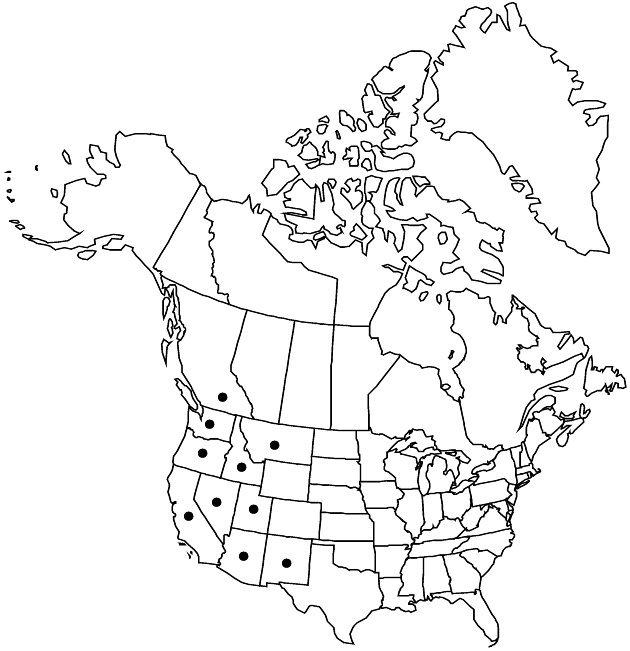Difference between revisions of "Agoseris heterophylla var. heterophylla"
FNA>Volume Importer |
imported>Volume Importer |
||
| (3 intermediate revisions by 2 users not shown) | |||
| Line 1: | Line 1: | ||
{{Treatment/ID | {{Treatment/ID | ||
|accepted_name=Agoseris heterophylla var. heterophylla | |accepted_name=Agoseris heterophylla var. heterophylla | ||
| − | |accepted_authority= | + | |accepted_authority= |
|publications= | |publications= | ||
|basionyms= | |basionyms= | ||
| Line 7: | Line 7: | ||
|name=Agoseris heterophylla var. glabra | |name=Agoseris heterophylla var. glabra | ||
|authority=Suksdorf | |authority=Suksdorf | ||
| + | |rank=variety | ||
}} {{Treatment/ID/Synonym | }} {{Treatment/ID/Synonym | ||
|name=Agoseris heterophylla subsp. glabrata | |name=Agoseris heterophylla subsp. glabrata | ||
|authority=(Suksdorf) Piper | |authority=(Suksdorf) Piper | ||
| + | |rank=subspecies | ||
}} {{Treatment/ID/Synonym | }} {{Treatment/ID/Synonym | ||
|name=Agoseris heterophylla subsp. normalis | |name=Agoseris heterophylla subsp. normalis | ||
|authority=Piper | |authority=Piper | ||
| + | |rank=subspecies | ||
}} {{Treatment/ID/Synonym | }} {{Treatment/ID/Synonym | ||
|name=Troximon heterophyllum var. cryptopleuroides | |name=Troximon heterophyllum var. cryptopleuroides | ||
| − | |authority= | + | |authority= |
| + | |rank=variety | ||
}} | }} | ||
|hierarchy=Asteraceae;Asteraceae tribe Cichorieae;Agoseris;Agoseris heterophylla;Agoseris heterophylla var. heterophylla | |hierarchy=Asteraceae;Asteraceae tribe Cichorieae;Agoseris;Agoseris heterophylla;Agoseris heterophylla var. heterophylla | ||
| Line 31: | Line 35: | ||
|elevation=0–2300 m | |elevation=0–2300 m | ||
|distribution=B.C.;Ariz.;Calif.;Idaho;Mont.;Nev.;N.Mex.;Oreg.;Utah;Wash.;Mexico (Baja California;Guadalupe Island);Europe (Sweden). | |distribution=B.C.;Ariz.;Calif.;Idaho;Mont.;Nev.;N.Mex.;Oreg.;Utah;Wash.;Mexico (Baja California;Guadalupe Island);Europe (Sweden). | ||
| + | |introduced=true | ||
|discussion=<p>Variety heterophylla is the most widespread of the varieties. It exhibits remarkable variation in cypsela morphology. K. L. Chambers (1963b) demonstrated that this small-flowered variety is strongly autogamous and does not outcross. The same breeding system may be present in other <i>Agoseris</i> taxa that exhibit reduced corolla and anther size (e.g., <i>A. apargioides </i>var.<i> maritima</i>, <i>A. grandiflora</i>, <i>A. aurantiaca</i>). Hybridization does not appear to be common; apparent intermediates with <i>A. apargioides</i> and <i>A. hirsuta</i> are known.</p> | |discussion=<p>Variety heterophylla is the most widespread of the varieties. It exhibits remarkable variation in cypsela morphology. K. L. Chambers (1963b) demonstrated that this small-flowered variety is strongly autogamous and does not outcross. The same breeding system may be present in other <i>Agoseris</i> taxa that exhibit reduced corolla and anther size (e.g., <i>A. apargioides </i>var.<i> maritima</i>, <i>A. grandiflora</i>, <i>A. aurantiaca</i>). Hybridization does not appear to be common; apparent intermediates with <i>A. apargioides</i> and <i>A. hirsuta</i> are known.</p> | ||
|tables= | |tables= | ||
| Line 40: | Line 45: | ||
-->{{#Taxon: | -->{{#Taxon: | ||
name=Agoseris heterophylla var. heterophylla | name=Agoseris heterophylla var. heterophylla | ||
| − | + | |authority= | |
| − | |authority= | ||
|rank=variety | |rank=variety | ||
|parent rank=species | |parent rank=species | ||
| Line 56: | Line 60: | ||
|publication year= | |publication year= | ||
|special status= | |special status= | ||
| − | |source xml=https:// | + | |source xml=https://bitbucket.org/aafc-mbb/fna-data-curation/src/2e0870ddd59836b60bcf96646a41e87ea5a5943a/coarse_grained_fna_xml/V19-20-21/V19_512.xml |
|tribe=Asteraceae tribe Cichorieae | |tribe=Asteraceae tribe Cichorieae | ||
|genus=Agoseris | |genus=Agoseris | ||
Latest revision as of 19:52, 5 November 2020
Stems 0 or 1 (internodes much shorter than subtending leaves). Leaves erect to spreading; blades (1–)3–15(–23) cm × (0.5–)2–10(–16) mm, mostly toothed, rarely lobed, lobes or teeth in 2–3 pairs, faces glabrous or densely, ± uniformly hairy. Peduncles 6–53 cm, lengths mostly (0.5–)1.5–4.5 times leaves at flowering, (1.5–)2–5 times leaves in fruit, glabrous or glabrate, or apically puberulent to villous. Heads 2–10(–12) mm wide at flowering. Phyllaries green or medially rosy purple, sometimes spotted, margins glabrous or ciliate, faces mostly hairy, occasionally glabrous, or villous, stipitate-glandular, translucent, yellowish or purple-septate and often purple-tipped trichomes, or eglandular with whitish opaque trichomes; outer erect to spreading, adaxially glabrous or puberulent and eglandular. Florets (5–)20–50(–100); corollas ± equaling phyllaries at flowering, tubes 1–4 mm, ligules 2–6 × 1–2 mm; anthers 1–1.5 mm. Cypselae: outermost strongly differing from inner, highly variable in color, shape, ornamentation, and pubescence; ribs flattened to alate, or 0, straight to strongly undulate, not diminishing proximally. 2n = 18, 36.
Phenology: Flowering Mar–Sep.
Habitat: Wet to dry, mostly seasonal habitats in deserts, grasslands, chaparral, steppe, oak woodlands, and open pine forests, often disturbed sites
Elevation: 0–2300 m
Distribution

Introduced; B.C., Ariz., Calif., Idaho, Mont., Nev., N.Mex., Oreg., Utah, Wash., Mexico (Baja California, Guadalupe Island), Europe (Sweden).
Discussion
Variety heterophylla is the most widespread of the varieties. It exhibits remarkable variation in cypsela morphology. K. L. Chambers (1963b) demonstrated that this small-flowered variety is strongly autogamous and does not outcross. The same breeding system may be present in other Agoseris taxa that exhibit reduced corolla and anther size (e.g., A. apargioides var. maritima, A. grandiflora, A. aurantiaca). Hybridization does not appear to be common; apparent intermediates with A. apargioides and A. hirsuta are known.
Selected References
None.